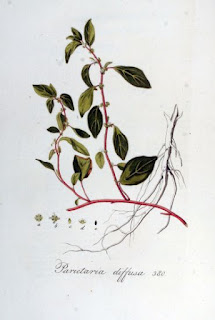


Left: Parietaria diffusa (syn. P. judaica) botanical drawing from biolib.de. Center: Parietaria officinalis botanical drawing from biolib.de. Right: A wall in Bergamo with Pellitory of the Wall.
Living in any Italian city, you are going to encounter stone walls: recent, roman, smooth, rough, short, and tall, and Bergamo is no exception. Bergamo is surrounded by one huge wall of 6.2 kilometers that the Venetians built in the second half of the 16th century.
Some plants like growing on walls. We talked about one such plant in the post The Flower that Grows on Walls - Cymbalaria muralis, Pennywort. As ubiquitous as Pennywort, is another wall-loving plant called Lichwort or Pellitory of the Wall, a plant in the genus Parietaria.
Parietaria is a genus of flowering plants in the nettle family Urticaceae, native to temperate and tropical regions across the world. The leaves of of Parietaria are non-stinging, unlike the common stinging nettle, Urtica dioica, annoyingly found exactly where you want to take a bathroom break while hiking.
There are two species of Parietaria, P. judaica (synonym P. diffusa) and P. offinalis that look similar. We believe what we are presenting in this post is P. judaica because it “seems” to be the more common of the two with a wider range, smaller leaves, a less upright habit, and a tendency to have woody stems at the base. However, we are not the only ones confused. Check out the confusion over the two species described in this Watsonia Journal article.
Both species of Parietaria are annual or perennial herbaceous plants growing to 20–80 cm tall, with green to pink to red-brown stems. The leaves are alternate, simple, entire, often with a cluster of small leaves in their axils. Individual flowers are produced in clusters of three to many together in the leaf axils.
The common name of Parietaria in English is the strange word “pellitory” thought to derive from Latin pariēs, meaning wall. (To our ears it sounds like a medical condition of the wall. Get that checked out ASAP.) In Italian, a wall as in a house wall is parete while the wall of a city is mura. Wall pellitory is not related to the Aster-family plant, Anacyclus pyrethrum, also called pellitory or Spanish chamomile.
One of the common Italian names for this plant is “vetriola” because this plant was commonly used to clean the inside of bottles and flasks aided by the microscopic hairs of its leaves. As a guess, we’d say this common name derives from from glassmaker – vetraio in Italian – with the suffix -iola added to indicate one who practices a profession. Other examples include boscaiolo – a woodcutter, who works in the forest or bosco and pizzaiolo – a pizzamaker or one who makes pizza. Sometimes the -iola suffix is used in a negative sense as in borsaiolo – a shoplifter or taker of a bag/purse or borsa.
Tired yet? Still reading? Another common Italian name for this plant is “muraiola” probably derived using similar logic above, except this time the ending is feminine probably because a plant is feminine in gender (la pianta) and not because a city wall (la mura) is.


Pellitory of the wall examples in Bergamo. All taken from the same wall, all likely Parietaria judaica.
No comments:
Post a Comment
All comments are moderated. If your comment doesn't appear right away, it was likely accepted. Check back in a day if you asked a question.